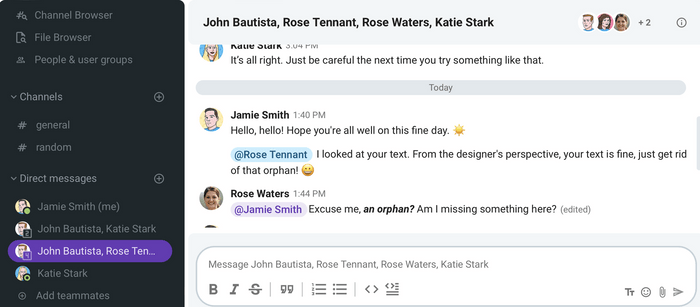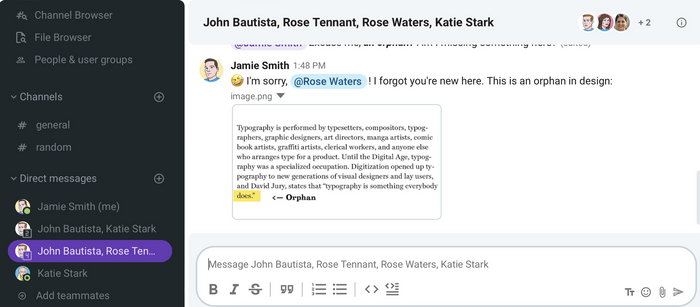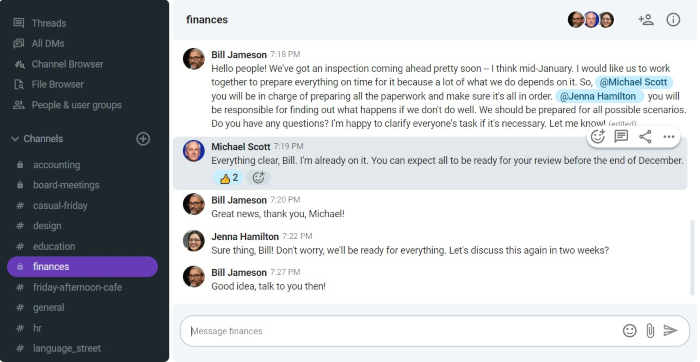Anyone can communicate, right?
Well, let’s do a pop quiz and see if that is true.
When someone is talking to you, are you:
- Engaging with the person talking to you, looking them in the eye, and really trying to grasp the meaning of what they are saying?
- Impatiently waiting for the other person to finish what they are saying to make your point?
- Thinking about a quick-witted reply and not really listening to what the other person is saying?
If your answer is A, congratulations, you are bonding with the other person, by actively listening to them. And there is a physiological explanation to this — both you and the speaker are producing neurochemical oxytocin, a so-called love hormone, which helps build trust and connection in any relationship.
If you answered with either B or C, that means you’re not actively listening and that you’re risking a communication breakdown.
Whatever your answer might be, don’t worry, we’ve got your back!
This blog post will help you understand communication breakdowns and avoid them in the future.
First, we’ll see what a communication breakdown is.
After that, we’ll consider the major causes and effects of communication breakdown, and show you how to avoid it altogether.
Let’s become better communicators!
Table of Contents
What is a communication breakdown?
If communication is the exchange of information between two or more individuals, a communication breakdown means not being able to get your message across properly.
When communication breakdown occurs, it usually results in a lack of communication.
In our search for answers, we reached out to Kassondra Glenn, a licensed master social worker, who told us:

”Communication breakdowns occur when the intention of what we are attempting to communicate does not match the impact on those who are receiving it.”
If you’re still unsure what a communication breakdown is, just be patient.
In the following paragraphs, we will consider major causes for communication breakdown and illustrate them with examples.
It’ll all be clear as a day to you before you can say “communication breakdown”.
Let’s dig in!
Major causes for communication breakdown in the workplace
For a company’s success, communication is crucial. Still, it doesn’t always go as planned. There are cases when all of us encounter some hiccups in communication.
Why do they happen, you ask?
Well, let’s look at some of the causes of communication breakdowns.
Cause #1: Relying on assumptions
We’ll start with the most common one — relying on assumptions.
This one’s on managers — it is their job to clarify to their employees who needs to do what.
So, managers must not assume anything and leave any little details unsaid.
What does it look like in practice? Here’s an example.
Example of a communication breakdown caused by relying on assumptions
Marjorie is the marketing manager in a large advertising company. They finally landed a big client and now they have to show their skills in the best possible way.
She called the two of her most creative copywriters — Diego and Natasha, and told them to come up with a slogan and an ad for their new client. However, she did not specify who should do what. They both came up with a slogan, but they didn’t have a new ad.
🔸 How did this happen?
Unfortunately, both Diego and Natasha assumed that they should come up with a slogan, without checking it with Marjorie or with one another first.
🔸 Clearing up
After realizing that she was being vague about the responsibilities of her subordinates, Marjorie apologized and decided to show both slogans to the client, so they could choose the one they liked better.
Aside from that, she extended the deadline for the ad and explained the whole situation to the client.
Cause #2: Believing everyone understands industry jargon
This one’s what Chip and Dan Heath called “the curse of knowledge” in their book Made to Stick: Why some ideas survive and others die.
Don’t worry, this has nothing to do with witches and fairy tales. Unfortunately, it’s very real and an everyday occurrence.
Namely, the person sharing an idea with their team has a lot more information about the idea in their mind than their listeners (especially new colleagues).
The people sharing ideas already know why the problem is relevant because they solved the puzzle in their head. Meanwhile, the listeners only have pieces of it and are — well, puzzled.
If you’re puzzled as well, here comes a good old example.
Let’s take a look at a conversation on a business messaging platform.
Example of a communication breakdown caused by believing everyone understands industry jargon
Jamie Smith, a lead designer, gives Rose Tenant, a writer, feedback about the visual aspect of the text she’s preparing for the social media post.
Rose Waters, from Sales, is in the same group in chat, but she’s just started working in the company.
She sees the term “orphan” which Jamie Smith uses in their chat, and is perplexed by it because she thinks of a child without parents.

🔸 How did this happen?
Being new in the company, as well as coming from the Sales department, Rose Waters is not familiar with designers’ lingo and is perplexed by Jamie’s remark. Perhaps she thought he was an evil Dickensian character who despises orphans.
🔸 Clearing up
Having realized the cause of this communication breakdown, Jamie explained that, in design, an orphan is a word that is left alone at the beginning of a line, separated from the rest of the text.

The air is cleared, and communication channels are once again flowing impeccably.
Cause #3: Cultural differences
According to the 2021 Global Employee Survey, 30% of the surveyed employees reported that they work directly with a team member from another country every day.
Although cross-cultural collaboration brings a fresh perspective to every company, it also comes with its own challenges, such as cultural differences.
Example of a communication breakdown caused by cultural differences
Robert Parker, a businessman from New York, is having a meeting with his business partner Oda Aimi.
He proposes a new business strategy and asks her if she thinks it is viable.
She says: “Yes” and Mr. Parker is more than happy he’s done a good job.
A few days later, Ms. Aimi sends him an email notifying him that they will end their cooperation by the end of next month.
Mr. Parker is perplexed. What had he done wrong?
🔸 How did this happen?
Mr. Parker should have researched business customs in Japan. If he had done that, he would know that in Japan, people are very sensitive to the word “No”. So, it is customary to respond with “Yes” even if they don’t agree with what is being said.
That’s why it’s best to avoid “Yes/No” questions when doing business with your associates and clients from Japan.
Always do research about the customs of the culture you’re doing business with, to avoid situations like this.
🔸 Clearing up
After the unpleasant situation, Mr. Parker read about the customs in Japan and realized his grave mistake.
Unfortunately, it was too late to save this deal, but he learned his lesson.
In the future, he’ll do his homework, before doing business with partners from other countries.
💡 Pumble Pro Tip
If you want to avoid mistakes like this, check out our article on perfecting cross-cultural communication at the workplace:
What are the effects of a communication breakdown?
So, the worst has happened — you came across a communication breakdown. Now what?
First things first, let’s assess the damage.
It can’t be that bad, right?
Well, let’s look at the most common effects of a communication breakdown.
Broadly categorized, they affect our mental health and work culture.
The effects of communication breakdowns on mental health
Communication breakdowns cause stress and low morale in your employees.
Namely, according to the 2021 report The Evolution of Communication, 7 in 10 Americans agree that mental health is tied to communication.
Therefore, when communication fails, employees’ mental health deteriorates, making them more stressed and anxious.
The effects of communication breakdowns on work culture
Communication breakdowns affect your work culture, too.
They may demotivate your employees and create tension amongst the team.
Furthermore, that kind of work culture may cost you your clients or business opportunities.
Aside from that, the disorganization that comes with communication breakdowns leads to higher employee turnover.
Unable to rely on organizational communication, your employees might turn to grapevine communication, which only further aggravates the work culture of your organization.
💡 Pumble Pro Tip
If employee morale in your company is low, check out our article on boosting employee morale in the workplace:
—
Now that we’ve covered the causes and effects of communication breakdowns, we’re more aware of its danger to the company.
That’s why our next step in this blog post are tips on how to avoid communication breakdowns.
Read on!
How to avoid communication breakdowns
Avoiding communication breakdowns is easier than mending their consequences.
If you’re having any doubts about it, we have some tips for you, that will help you avert breakdowns in your workplace communication.
So, without further ado, let’s get to it!
1️⃣ Build an internal communication plan
According to Galagher’s report State of the Sector 2022, only 31% of the surveyed say they have an internal communication strategy.
This is devastating news, especially if we take into account the words of Benjamin Franklin:
“If you fail to plan, you are planning to fail!”
So, if you want to communicate with your coworkers without any glitches, first, you should make an internal communication plan. It should include your:
- Organization’s objectives,
- Missions, and values,
- Communication channels,
- Staff responsibilities and processes, as well as
- Key business messages.
Of course, having a plan for communication doesn’t make you immune to communication breakdowns — but it certainly does lower the chances of them occurring.
💡 Pumble Pro Tip
If you need any help in coming up with an internal communication plan, you can find all the necessary information and even templates in our extensive guide on planning internal communication:
2️⃣ Define the chain of command
To avoid breakdowns in workplace communication, you should strive towards clearer communication — everyone should know who to talk to and report to.
A manager should be in charge of the flow of information, and oversee the entire process.
Aside from that, managers should give constructive feedback to their employees about their specific roles in a project’s success to keep them in the loop.
Here’s what Mark Grimm, a communications specialist, had to say about this:

“Everyone should be kept updated on how success is measured and what specific role each person plays in creating that success. Compensation should be tied directly to what management says is important.”
In other words, if you want to motivate your employees and avoid any misunderstandings, be specific about their tasks and roles in a project.
Let’s look at an example of a manager delegating tasks to their employees.
Bill Jameson is announcing to his employees that an inspection is coming to their company, and he wants to get ready for them on time.
That’s why he delegates tasks to his coworkers so that they can be prepared for everything.

If you follow Bill Jameson’s leadership style, you’ll be one step closer to a workplace free from communication breakdowns.
3️⃣ Create an atmosphere of trust
Your employees should work in an environment that makes them feel comfortable and safe, as well as free to speak up their minds.
Moreover, they should be able to ask for any necessary clarifications.
Mark Grimm, one of our experts, agrees:

“Employees must feel comfortable taking risks, criticism of any risk-taking will mean you’ll get less of it. Every employee should be clear on what is expected from them and why that role is in their interest. There must be an atmosphere of trust and candor and the constant cultivation of the approach that merit matters.”
Only then can you be sure that your employees will freely ask further questions if something is unclear to them.
That’s a good way to steer clear of communication breakdowns.
4️⃣ Actively listen
Another useful way to do so is to actively listen to the other party.
It means you need to be engaged with your conversation partner in a positive way.
So, listen attentively to what is being said, paraphrase the words and reflect back.
One of the experts we consulted, Kassondra Glenn, agrees:

“We can avoid communication breakdowns through asking for clarification and practicing active listening. These tools help us to move away from being closed off and into a more receptive, open communication stance.”
Likewise, in her article, clinical psychologist Arlin Cuncic states that active listening at work is especially important if you frequently interact with colleagues.
She highlights the importance of active listening in understanding problems and collaboration.
That’s why she’s offering a few tips for active listening:
- Pay attention to the speaker.
- Reflect on what you hear.
- Withhold judgment.
- Ask open-ended questions.
- Be patient.
With Ms. Cuncic’s advice, you’ll surely hone your active listening skills.
5️⃣ Choose the right software tools
According to research on workplace communication, 57% of people like to use instant messaging platforms, including business communication platforms.

A communications expert and editor at Mantelligence, Jasper Chase, provided us with some insight on this matter:

“Whether face-to-face, through email, or instant messengers, there needs to be a platform for people to communicate with each other, or else they will fail to communicate at all.”
So, to avoid communication breakdowns, choose your platform for communication.
However, when choosing the software tools, you should keep in mind your team’s needs.
Carefully assess your communication needs and choose the software accordingly.
💡 Pumble Pro Tip
If you feel overwhelmed by the sheer number of software tools on the market and you’re not sure which to choose, check out our guide on the best team communication tools:
6️⃣ Don’t assume — overcommunicate
Our last tip is actually 2 in 1: don’t assume anything — overcommunicate instead.
So, first of all, never assume anything.
We all have different backgrounds and come from different cultural contexts.
Just because something goes without saying for you, it doesn’t mean you can leave out information and expect others to understand you.
That’s why we must not forget to overcommunicate if we truly want to be understood.
However, keep in mind that overcommunication is not a synonym for information overload.
We’re not suggesting that you should info-dump or bore your colleagues — but rather deliver important information, in detail, at the right time, to the right people.
Wrapping up: It’s easier to avoid communication breakdowns than deal with their consequences
Communication breakdowns can easily occur, but are, luckily, just as easily avoided.
Although they affect our mental health and work culture, there are tried and tested ways to avoid them.
So, keep away from assumptions of any kind and be careful with the business jargon and cultural differences.
If you pay attention to these major causes and follow our advice on avoiding them, you can rest assured that your workplace communication will improve.
So, the next time you’re talking to your coworker, look them in the eye, listen attentively — and work on that oxytocin level.




